Best film cameras 2024: the finest classic and new analogue cameras you can buy
We pick out the best film cameras you can buy right now
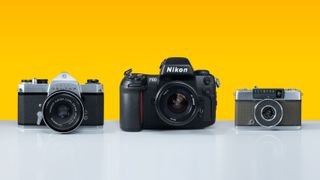
With the best film cameras, you can get back to the roots of analogue photography. But if you’re confused about where to start, we’ve got some answers for you. Whether you’re in the market for a vintage SLR, a classic instant camera, or even something brand new, you’ll find a camera for you in our list.
Between us, we’ve got decades of experience with film cameras, so you can be sure that all of the recommendations in this list are well worth considering. We’ve split the list into second hand and new to help you find the best film camera for you.
Lots of people are flooding to film photography for a variety of reasons. Despite the obvious technological advantages of using the best digital cameras for photography, analogue photography is still considered something special and unique. Yes, it involves hassle and it doesn’t always produce perfect results - but that’s exactly what makes it so appealing to many. And, what’s more, it’s far more authentic than just slapping a quick and dirty filter on your digital filters.
Using film is also a great - if not at times, brutal - way to learn the essence of photography. If you’re a beginner it’ll be a steep learning curve, but it’s great for those who enjoy a challenge.
Our round-up includes the best film cameras for beginners, advanced and professional-level photographers. When you’re buying a film camera, there’s a set of considerations to think about which may be entirely different from when you’re looking towards digital. If you need a more in-depth guide on what you should be looking for, scroll to the bottom of this page to find some tips.
For those new to the film game, the first thing you’ll probably want to think about is which format you want to shoot in. It’ll come as no surprise to anyone who has a basic level of knowledge that 35mm is the most commonly used film format - indeed it’s what the sensors inside “full-frame” digital cameras are based on. These are good if you want something which is a good, portable size and isn’t too expensive compared with medium format.
What you benefit from with medium format however is much larger negatives, which generally produce more detailed and sharper results (lens dependent), but usually for a much higher price tag.
It’s also worth thinking about the lenses that you intend to use. A wide lens selection can be difficult to find if you pick up a camera which is made by an obscure company which made very limited runs. Larger camera brands though will give you a lot more options, as well as additional accessories, mount adapters and so on.
So - after all that - what is the best film camera? On the second hand market, we think it has to be the Nikon F2. This is an all-time classic, a 35mm fully-mechanical SLR which was extremely popular for years. It’s reliable and has a god range of features which should suit the needs of most who want to get into film photography. It’s also well-priced too.
This is just one of many great options however, let’s take a further look at our list of the best film cameras you can buy (new and used) in 2022.
Best film cameras 2022
Why you can trust TechRadar
Best used film cameras
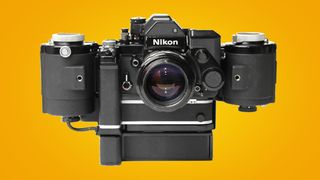
1. Nikon F2
Specifications
Reasons to buy
Reasons to avoid
Epic build quality, loads of features, timeless styling, and superb reliability make the Nikon F2 our favorite film camera in our roundup. After the legendary Nikon F hit the scene it was two decades until Nikon superseded it with its next camera, and boy did it deliver. All mechanical with a shutter made from titanium, the F2 is as modular as it came in the 1970s with interchangeable viewfinders, motor drives, and meter prisms. It even featured an extremely useful 250-exposure back that fed into a 10-meter film roll (though they’re now as rare as hen's teeth).
The F2 is also compatible with every Nikon SLR lens, so owners have spoilt for choice thanks to the incredible range of high-quality glass that Nikon has produced. The only downside is that the camera body itself (without a lens) comes in at nearly a kilogram (840g), so we have found that trekking around with it up to your eye all day long can leave a slight strain on the arms. While there may be technically better-equipped SLR cameras out there, we’re willing to bet you won’t find a better one for the second-hand price nowadays.
Buy a used Nikon F2 on ebay.com
Buy a used Nikon F2 on ebay.co.uk

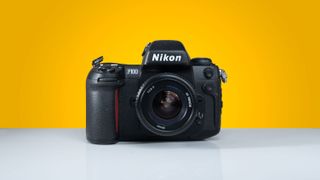
2. Nikon F100
Specifications
Reasons to buy
Reasons to avoid
The beauty of the Nikon F100 is that it’s accessible to a range of different photographers and experience levels. If you're a beginner or an intermediate snapper, it's pretty easy to get your hands dirty thanks to the comprehensive PASM (Program, Aperture Priority, Shutter Priority, Manual) modes.
The magnesium body gives the camera strength and durability without weighing it down – despite its size, it comes in at just 785g. That may in part come down to the fact that the back of the camera is formed from plastic.
Autofocus is expertly controlled through the use of the Multi-CAM1300 AF system, which gives a wide AF coverage with five separate points (top, bottom, center, left, and right). Such a powerful AF system (at least, powerful for the time) means shooting fast and maintaining sharpness is certainly possible. Thankfully, the F100 captures photos at 4.5 frames per second, or up to 5 AF FPS, with the MB-15 battery grip, too.
Buy a used Nikon F100 on ebay.com
Buy a used Nikon F100 on ebay.co.uk

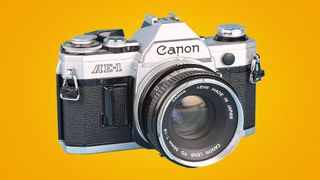
3. Canon AE-1
Specifications
Reasons to buy
Reasons to avoid
There’s a reason why Canon sold an unprecedented one million units of these cameras back in the day. It was the first microprocessor-equipped SLR the world had ever seen in a production camera and was designed to be lightweight thanks to advancements in electronics technology.
Capitalizing on this advance, the AE-1 has a tightly packed aluminum body held together by strong plastics. This camera marked Canon’s departure from full-mechanical, heavy-metal cameras, into a more portable and lightweight future. It’s also because of this introduction of a plastic structure and cloth shutter that Canon was able to keep the price down, making it viable for beginner photographers.
It features two control modes, both shutter priority, and manual, and shoots up to 1/1000 sec. It also includes a built-in center-weighted light meter for judging exposures. Unfortunately, it’s only compatible with FD mount lenses but can also be used with older FL-mount lenses with the use of stop-down metering, or EF-mount lenses with additional third-party mount adapters. One additional fun fact: the shutter release sound for this camera is the exact sound one hears when taking photos on the iPhone.
Buy a used Canon AE-1 on ebay.com
Buy a used Canon AE-1 on ebay.co.uk

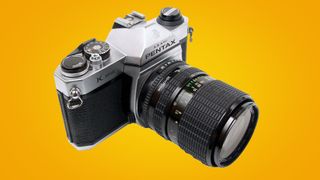
4. Pentax K1000
Specifications
Reasons to buy
Reasons to avoid
Coming in at the lower end of the price scale, the Pentax K1000 is renowned as a starter film camera for budding photographers, especially students. But even though it’s one of the cheaper 35mm SLRs on this list, that certainly doesn’t detract from its usability.
Stripped back and keeping things simple, the K1000 has just three shooting controls: focus, aperture, and shutter speed. This helps to encourage photography newcomers to pick this camera up because the no-frills approach is so accessible.
There are no electronics to go wrong in this SLR, with a battery only operating the light meter should you wish to use it. Otherwise, the fully mechanical metal body shoots without issue. On the top just behind the pentaprism is a hot shoe for mounting flashes, plus shutter speed and ISO (ASA) alteration on the top dial. The viewfinder also has an 0.88x magnification, which gives a nice unrestricted view into the scene to help aid your composition.
Buy a used Pentax K1000 on ebay.com
Buy a used Pentax K1000 on ebay.co.uk

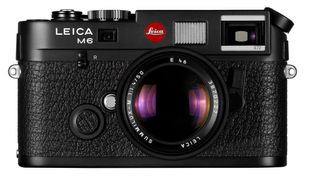
5. Leica M6
Specifications
Reasons to buy
Reasons to avoid
Leica M rangefinders will always be controversial and can take a bit of getting used to. However, the rangefinder focusing is fast and precise in the right hands but takes some learning. But once mastered the M6 can produce some fantastic results, it has been a fan favorite for some time, and now has a rather cult following in the film community, so you will have to pay a hefty price to get a good one. This is only the start because Leica lenses are equally expensive. But if you like your film photography to be stripped back to its basics, the M6 will oblige. You'll need to apply the settings yourself and you'll need to focus yourself, but for Leica M fans that's what it means to be a photographer.
Buy a used Leica M6 on ebay.com
Buy a used Leica M6 on ebay.co.uk
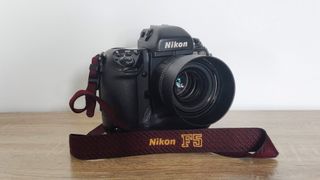
6. Nikon F5
Specifications
Reasons to buy
Reasons to avoid
The Nikon F5 is the last professional-bodied, fully autofocus film SLR that was produced by the company. Today, it is your best bet if you are looking for a truly advanced film SLR that features great autofocus, aperture, and shutter priority modes, as well as being able to use fully manual lenses. The F5 also automatically reads your film speed so not dialing in your ISO manually. With all these advanced professional features and pro body styling, you do sacrifice portability slightly, the F5 is built like a tank, but that means it is a rather weighty camera that wouldn't necessarily be a top choice for a travel camera however, for anything else it would be the best "go to" for the job.
Used Nikon F5 deals on eBay.com
Used Nikon F5 deals on eBay.co.uk
Used Nikon F5 deals on eBay.com
Used Nikon F5 deals on eBay.co.uk
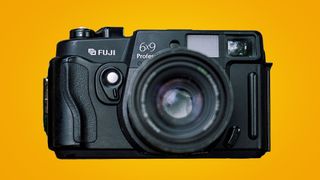
7. Fuji GW690III
Specifications
Reasons to buy
Reasons to avoid
The Fuji GW690III is a portable medium format rangefinder camera that produces sharp results thanks to its fixed lens. Its fixed Fujinon 90mm f/3.5 lens is pin-sharp down to the minimum focusing distance of one meter. And thanks to the lens' hardy, metallic built-in hood, it also counteracts flare nicely.
Despite being a medium format camera, and larger than the typical 35mm SLRs of the time, the all-plastic casing keeps weight down to 1,460g with dimensions of 201 x 119 x 129mm. To keep track of photos there’s a shutter actuation counter on the underside of the body, and to ensure things are level throughout a spirit level features on the top plate.
The aperture ring is situated on the lens barrel, as you'd expect, but so too is the shutter speed selector, hidden beneath a pull-out mechanism on the lens – something that might catch SLR shooters off-guard while transitioning to this camera. There are two shutter releases, one on the top and one at the front of the camera body, which may make portrait shooting slightly easier.
One of the biggest draws of the GW690III is the huge 6x9 negatives it produces, which seemingly approaches large format dimensions. Fortunately, for those 35mm shooters, the aspect ratio is almost identical to 35mm, so the composition remains largely familiar.
Buy a used Fuji GW690III on ebay.com
Buy a used Fuji GE690III on ebay.co.uk


8. Canon A2 / EOS 5
Specifications
Reasons to buy
Reasons to avoid
The Canon A2 (known as the EOS 5 outside the US) is a solid, well-equipped SLR from the early 1990s that packs a punch in a lightweight body that weighs just 675g. It has five focusing points which are selectable by dial operation or via the camera, but it also has a magical feature: Eye Control.
Simply look at one of the five focusing points and the A2 will select that point for you. It’s a truly inspirational feature and one that you’d be lucky to find in a future digital camera. If you want to preview the depth of field, there’s also a sixth point to look at with your eye to see how the photo will look with the chosen aperture setting, in advance of shooting.
Alongside this, the A2 can shoot any shutter speed from 30 seconds right down to 1/8000s, meaning you can freeze the action or keep things moving with long exposure. If the light conditions change, the camera's 16-zone evaluative metering, 3.5% spot metering, and center-weighted average metering, plus the built-in flash, mean you won't get caught out either.
Buy a used Canon EOS A2 on ebay.com
Buy a used Canon EOS 5 on ebay.co.uk

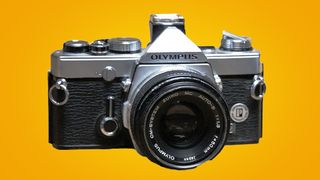
9. Olympus OM-1
Specifications
Reasons to buy
Reasons to avoid
The crowning feature of the Olympus OM-1 is its magnificently big and bright optical viewfinder. With a magnification of 0.92x, you can practically wear the camera like a monocle, with great views of your scene. This helps you engage with your subject and spot potential compositions that would otherwise be missed on other cameras.
If portability is important, then the OM-1 is certainly a fine choice. At just 510g, it’s one of the lightest SLRs on our list and stands tall (read: short) at 136 x 83 x 50mm in stature. This is tiny compared to its 35mm rivals from the 1970s, and is largely thanks to the team that designed Olympus' Pen and Pen F cameras, which are also known for their compact size.
The OM-1 is great for photographers of all skill levels, but beginners will need to sharpen up their exposure theory because its fully manual operation means balancing aperture, shutter speed, and ISO is a must. It has no automatic or semi-automatic features, but if you're okay with that, it's a fantastic second-hand option.
Buy a used Olympus OM-1 on ebay.com
Buy a used Olympus OM-1 ebay.co.uk


10. Mamiya C330
Specifications
Reasons to buy
Reasons to avoid
Aimed at professionals and serious amateurs, the Mamiya C330 sought to offer a lower price point than other high-end medium format cameras in the 1970s.
Unlike many other twin-lens reflex cameras though, the C330 (in fact, the whole C-series line-up by Mamiya) featured the ability to change lenses, which offered up focal lengths of between 55mm and 250mm. This made it useful as both a camera for outdoor shooting (if you had strong enough arms to carry the hulking 1.7kg frame) and indoor studio use, with the longer focal lengths being perfect for portraits and headshots.
As big and heavy as this camera is, there are also plenty of accessories to extend its capabilities, including backplates for sheet film, two types of grip-holders, different finders, and interchangeable focusing screens. Focusing comes in the flavor of bellows and there’s even a parallax minder for compensation of converging verticals, should you need it. Its 120 film gives 12 exposures, whereas 220 film bumps this up to 24 exposures for more shooting.
Buy a used Mamiya C330 on ebay.com
Buy a used Mamiya C330 ebay.co.uk


11. Rollei 35 S
Specifications
Reasons to buy
Reasons to avoid
Small, lightweight, and simple to use, the Rollei 35 S is ideal for street photographers who need to move around without a weight lump strapped to their neck.
Zone focusing is a must with this camera, but again that makes it good for street photographers who are used to stopping down the aperture and adjusting the shutter speed for correct exposure. On the other hand, it might make things a little trickier for photographers who aren’t used to this style. Still, this does mean that photographers can shoot without bringing this camera up to their eye, for even more inconspicuous use.
In an effort to keep the form factor small, the 35 S has some peculiar design choices that might at first seem counterintuitive. For instance, there’s a hot shoe mounted on the bottom of the camera. The frame advance knob is also on the left when shooting and winds the film in the opposite direction to standard 35mm cameras, while the aperture and shutter speed selection dials flank the lens on the front of the body. While all of this can be initially confusing, it does also make the 35 S one of the smallest 35mm cameras ever made.
Buy a used Rollei 35 S on ebay.com
Buy a used Rollei 35 S ebay.co.uk

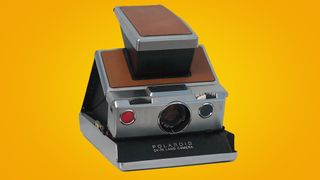
12. Polaroid SX-70
Specifications
Reasons to buy
Reasons to avoid
Featuring a beautiful chrome body, the SX-70 is still available in photographic circles today via Polaroid and other third-party companies, that refurbish these cameras. Not bad considering it became the first instant SLR camera ever made nearly 50 years ago.
Using SX-70 instant film you can get immediate feedback due to the chemical reactions that get to work after making your exposure. It’s perfect for shooting outdoors in plenty of bright sunlight because of the ISO 100 film and the fixed f/8 aperture. Focusing is simple by using the autofocus, or alternatively, you can switch to manual focusing and use the focusing wheel above the shutter release to get as close as 30cm. If indoor shooting is what you need, there are also optional flashbars that can be fitted to the top of the camera to fill light. A superior glass lens (an improvement on the plastic lenses seen on today's Polaroid Original cameras) produces sharp photos, too.
The almost cult-like following of the SX-70 has introduced many useful modern accessories for the contemporary shooter, including holders and reusable flash and lens filters, which keeps this camera feeling fresh and usable.
Buy a used Polaroid SX-70 on ebay.com
Buy a used Polaroid SX-70 ebay.co.uk

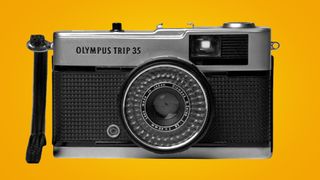
13. Olympus Trip 35
Specifications
Reasons to buy
Reasons to avoid
The Trip 35 arrived in 1967 and came at a time when tourism was booming, so it was destined to become a popular, classic travel camera. A compact camera that was easy to slip into your pocket, it captured great, sharp photos thanks to its fixed 40mm f/2.8 lens.
Combined with some suitably fast film, that maximum aperture makes this camera ideal for any kind of travel snapping, whether you're outside, indoors, or in low light conditions. To help, the ISO (or ASA as it was then known) was designed to be kept below 400 using the ISO selector on the lens.
For true photophiles, it may lack a little in features, with aperture and shutter speed being automatic. It is possible to manually adjust the aperture should you require it, but it is restricted to just four different distance focus options from close portrait shots to distant mountain tops. Still, for those new to film photography or looking for a fun travel camera, this camera's simplicity and minimal settings are ideal.
Buy a used Olympus Trip 35 on ebay.com
Buy a used Olympus Trip 35 ebay.co.uk
Best current film cameras
Looking for something a bit shinier than a second-hand model? These film cameras are all still in production today.
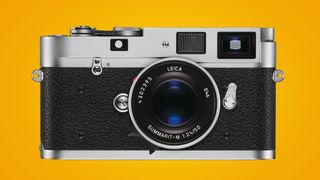
1. Leica M-A
Specifications
Reasons to buy
Reasons to avoid
Following the tradition of Leica’s M camera line-up, the M-A has certainly been designed with one foot in the past and the other in the present. A one-piece, full-metal body is finished in either black or silver chrome and provides photographers with a solid feel in the hand. Though durable by design, it’s also lightweight at just 578g.
This is a film camera for either intermediate or advanced users or beginners who like to swim uphill because it’s fully manual without even providing so much as a light meter for those who want to crack their exposure.
Leica’s film of choice for the M-A is the classic Kodak Tri-X 400 black-and-white film, a familiar favorite among artists and reportage photographers alike – so much so that Leica actually packs a roll with every camera. The rangefinder functions can take a bit of getting used to, with focusing and camera settings taking a while to get right, but the smooth, well-machined aesthetics mean it’s a pleasure to hold and shoot with.

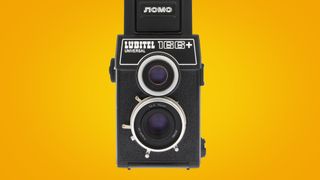
2. Lomography Lubitel 166+
Specifications
Reasons to buy
Reasons to avoid
Based on the Russian camera of the same name, the Lomo Lubitel 166+ takes its design style from twin-lens reflex (TLR) cameras from the 1940s and 50s. Lubitel, which in Russian means 'amateur', is aimed at exactly that – those who want to get into medium format via a TLR camera without the extravagant expense that often puts newbies off.
That said, if you prefer to switch to a roll of 35mm film, you can also do that too with the Lubikin 35mm kit that the 166+ is shipped with. A simple frame advance knob also allows for easy multiple exposure shots that produce wonderful, creative effects.
Focusing is simple thanks to the ground-glass focusing screen, which helps you dial in a sharp image on the top viewfinder, while the 75mm lens focuses relatively close with a minimum focusing distance of 0.8m up to infinity, which should cover almost all types of photos aside from macro work.


3. Lomography Diana F+
Specifications
Reasons to buy
Reasons to avoid
If you’re on a budget and want that lo-fi retro effect, then the Diana F+ is probably the ideal film camera for you. It lets you capture images on 120 film (or 35mm film, thanks to a Diana+ 35mm back) in either 12 full-frame square shots (5.2 x 5.2cm) or, alternatively, 16 smaller square images (4.2 x 4.2cm). Handily, the Diana F+ also allows for an endless panorama in 46 x 46mm formats.
Its body is made from lightweight plastic, which does feel cheap to the hand, but this also helps the Diana+ achieve that super-low price. This camera is great for novices or those who come from instant film camera backgrounds with limited technical control. It comes with three available apertures, listed as cloudy (f/8), half-shade (f/11), and sunny (f/16). But take the lens off and you also have the ability to shoot pinhole images for more creative fun.
To make up for the limited aperture options and two shutter speeds (1/60 sec and Bulb) the Diana F+ comes with a Diana Flash Plug, which slots into the top of the camera to provide extra light in dark situations or when you need a splash of fill light. There’s also a set of handy colored gel flash filters to experiment with, which rounds one of the most fun, versatile film cameras around.


4. Lomography Konstruktor F
Specifications
Reasons to buy
Reasons to avoid
The Konstruktor F+’s big selling point is the ability to literally build your own camera. The DIY element brings with it an extra layer of satisfaction when capturing images, knowing that you’ve both made the camera and managed to balance exposure and composition to produce your photographs.
Incredibly affordable, this makes a good gift for those who are into photography at any level, whether ranked amateur or a seasoned pro. There’s also room for expansion with the ability to add the Konstruktor Flash Accessory Kit which slides straight into the existing camera thanks to the PC socket.
The TLR viewfinder at the top of the camera also allows waist-level shooting for inconspicuous shooting which makes it ideal for street or reportage, or indeed anywhere that you don’t want to draw attention in an age where a smartphone in the face can get people’s backs up. Overall, a lot of fun and photos in a small, inexpensive package.


5. Spinner 360
Specifications
Reasons to buy
Reasons to avoid
Perfect for creative shooters who want to step away from standard rectangular framing, the Spinner 360 lets you shoot extreme panoramic images using every inch of the scene around you.
The textured handle grip and lightweight design make it easy to take the Spinner 360 with you on adventures, and it doesn't even need battery power. Alternatively, if you’re not vegan, you can get the leather edition where the device is wrapped in fancy Italian Toledo leather.
Thanks to a simple pull cord, the camera is incredibly simple to operate. And the great news is you don’t need any complicated, bespoke kit to capture shots, as it uses standard 35mm film. However, between the cost of purchasing the film and the developing costs, things could get pricey for you (depending on the type of film you’re using) as you’ll only capture up to eight, 360-degree photos per standard 36 exposure roll. Still, it couldn’t work any other way as the 360-degree angle needs space on the film to expose a full rotation of the scene.
There’s also the Spinner 360 Motorized which allows photographers to take 360 shots from afar and even inside thanks to the wireless remote link, but bear in mind this device costs just as much as the camera does.

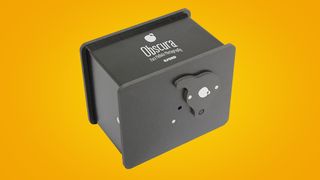
6. Ilford Obscura Pinhole
Specifications
Reasons to buy
Reasons to avoid
The Ilford Obscura Pinhole camera is a gloriously simple, yet unique, 4x5in film camera built in the UK. It’s structurally strong and impact resistant, being constructed from ABS plastic with stainless steel fixings for added longevity.
Pinhole cameras produce a naturally soft image because there’s no glass element to focus the light. This means a smaller, sharper hole is required for the maximum possible clarity in pinhole photography. That’s why the Ilford Obscura has a chemically-etched 0.35mm pinhole, which gives an effective aperture of f/248 for maximum sharpness with a focal length of 87mm.
For those needing a little extra help getting set up, the camera also comes with a tripod mount adapter and an exposure calculator for nailing the perfect shot when you're out in the field. Due to the long exposures needed with pinhole photography, capturing moving subjects is tricky, but landscapes and scenes with moving water, clouds, or traffic, with other parts of the scenes holding steady, work wonderfully.
How to choose a film camera
1. Film type
There are two main types of film camera formats we’ve included in our guide, 35mm and medium format. The difference lies in the size of the negatives (or positives) that the cameras can produce, with larger formats able to deliver more detail and print to larger sizes. However, they’re often more expensive, bigger and bulkier than their 35mm cousins.
2. Lens types
Film cameras come with a variety of lens types. Some are fitted with fixed, prime lenses that can’t be swapped out, whereas others have two or three interchangeable lenses from which to choose from. If you want a large range of lenses you’ll need to go to manufacturers such as Nikon, who have exceptional forward and backward compatibility, meaning the lens range you can choose from is huge.
3. Build quality
Are you someone who dotes on their precious devices, or do you need your kit to keep up with you in rugged and extreme environments? Depending on your answer it might be useful to look at what the film camera body is made from. Bodies that are majority plastic are usually fine for general use but can break or shatter more easily than bodies constructed from metal.
4. Flexibility
Film photography is a tough discipline to crack, with no instant feedback via a rear screen and long wait times for film development. So it might pay to weigh up how flexible your film camera needs to be. Are you interested in just shooting pinhole images, or will the uniqueness of a 360 camera quench your photographic thirst? A general 35mm compact camera might be all you need for street or travel photography, for instance.
5. Size
The form factor of your film camera is important, too. For those wishing to travel with their camera a small, compact camera with a fixed lens might be the best option. But if you’re happy to carry around something a bit bulkier, perhaps with a heavy tripod, then maybe a medium format camera is the better option.
- These are the best instant cameras you can buy right now
- Or check out our guide to the best cameras for kids
- The best compact cameras in the world
- Discover the best travel camera for your next adventure
Get daily insight, inspiration and deals in your inbox
Get the hottest deals available in your inbox plus news, reviews, opinion, analysis and more from the TechRadar team.
- Mark WilsonSenior news editor
